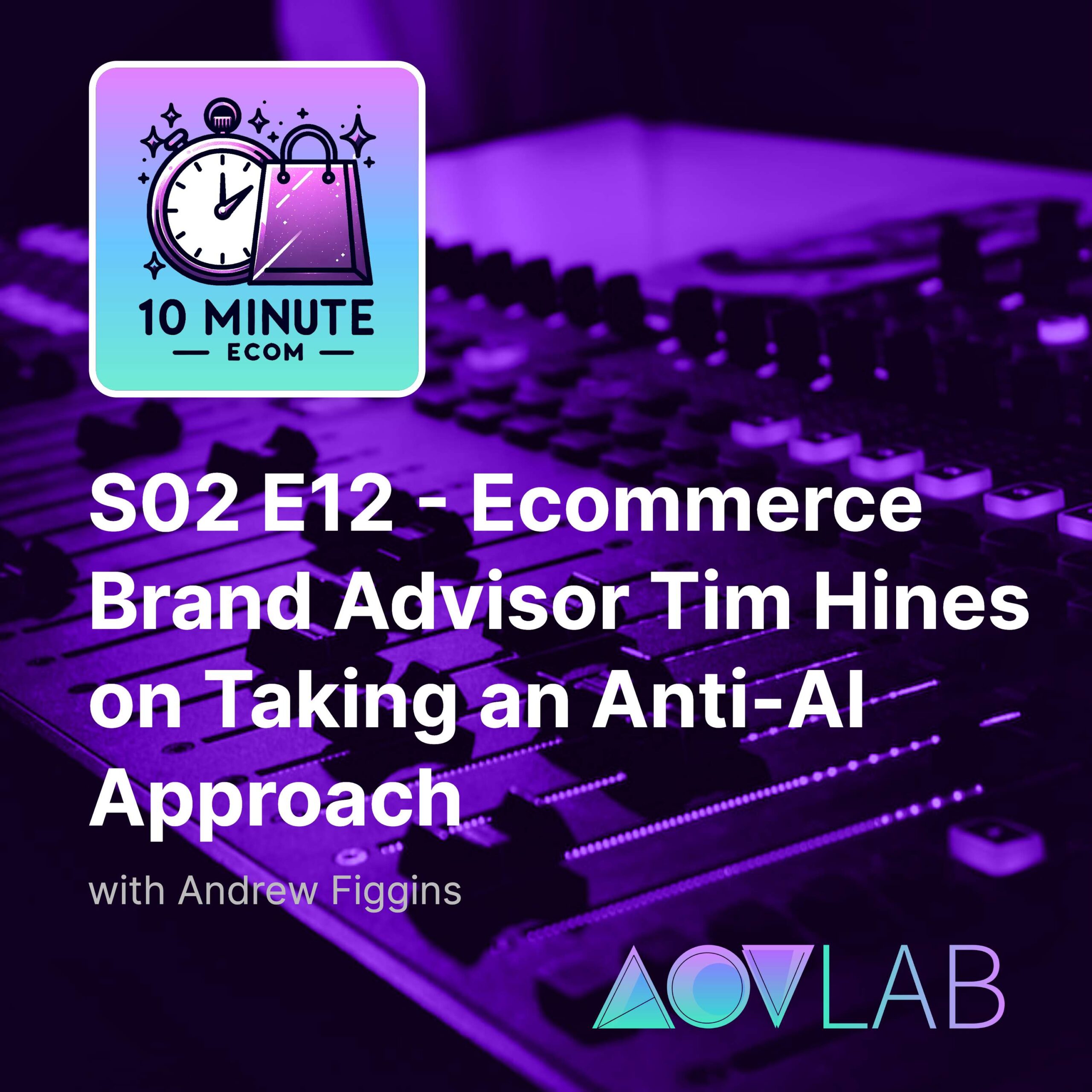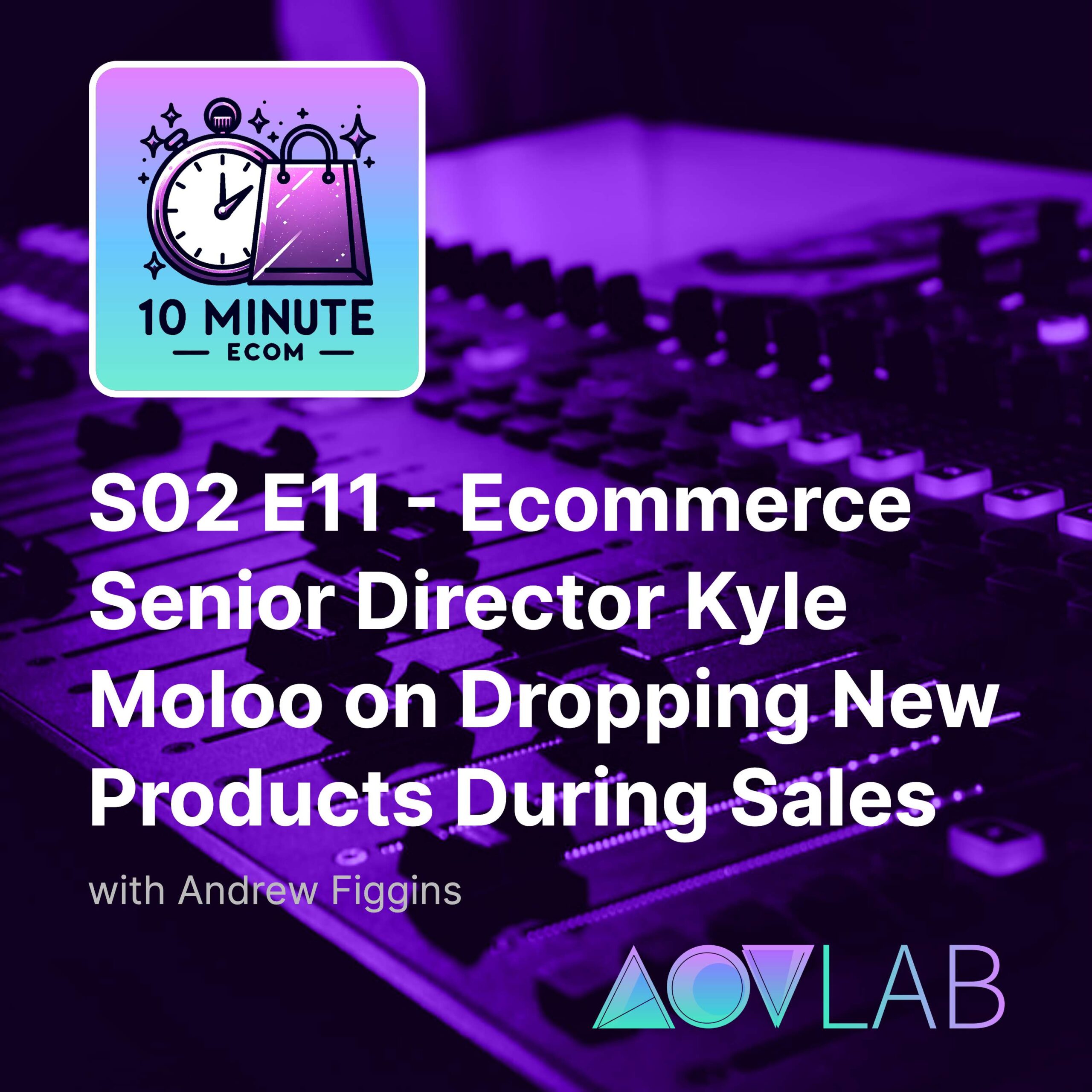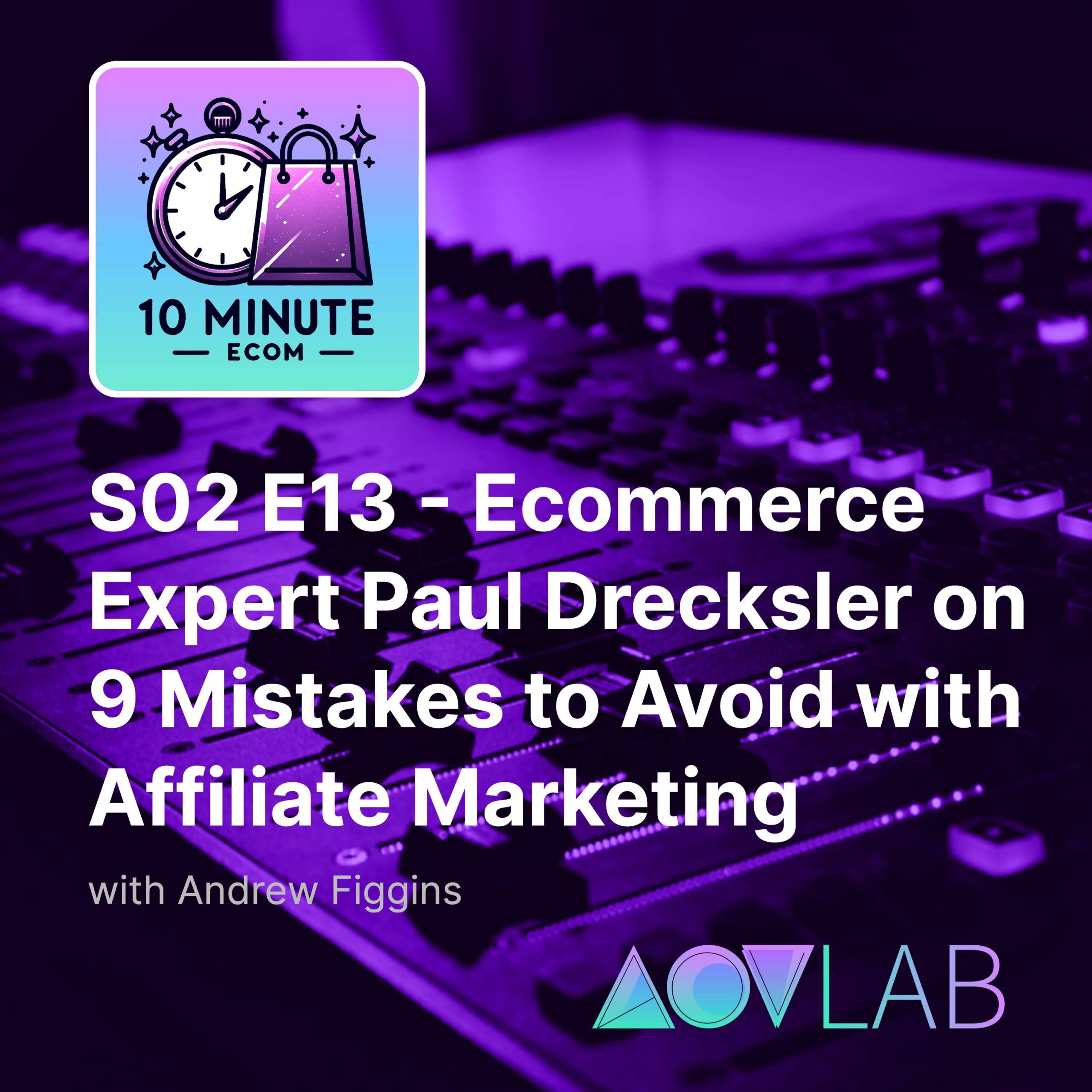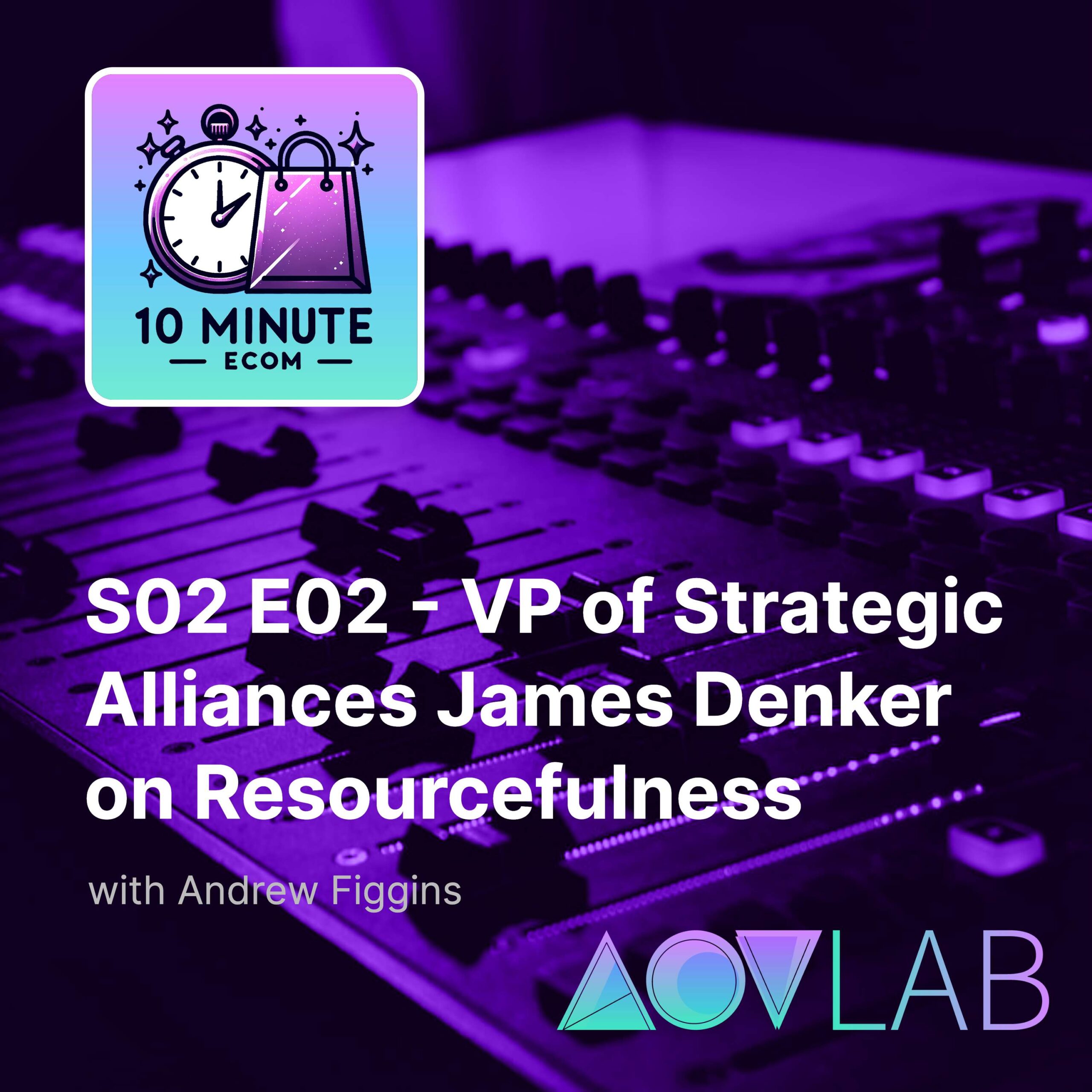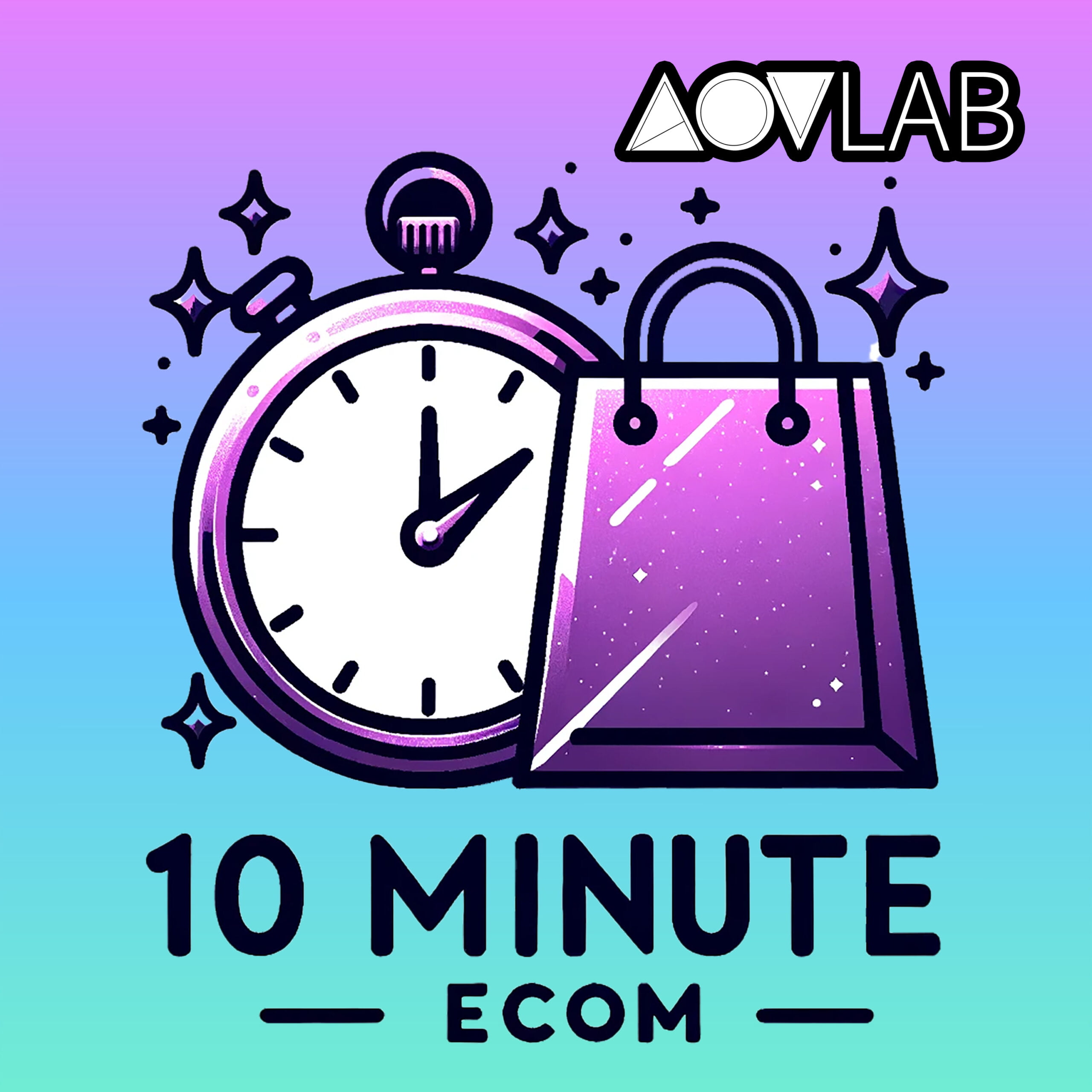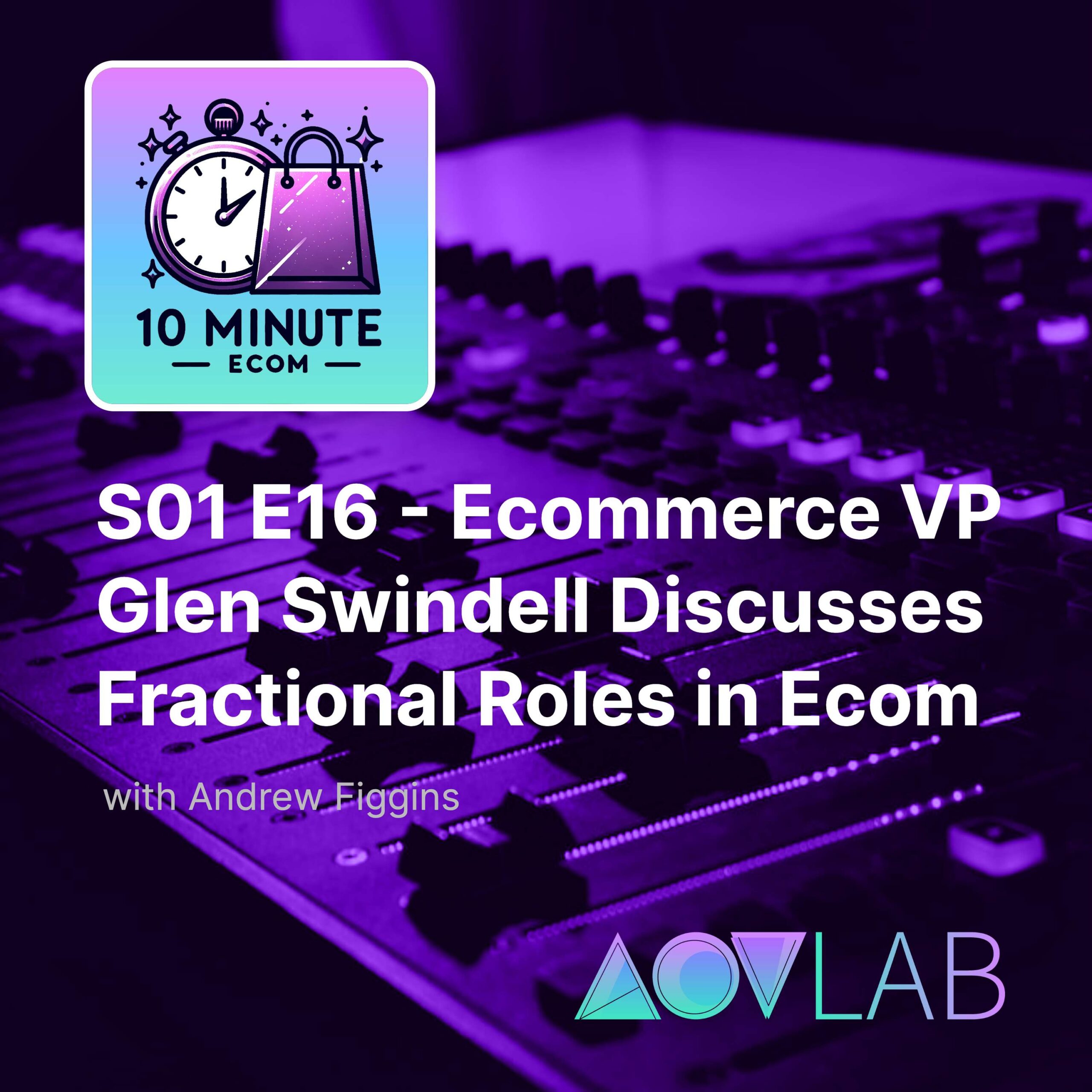View Full Transcript
Episode Transcript
[00:00:07] Speaker A: Hello, ecommerce fans, and welcome to ten minute Ecom and AOV Lab podcast. Every episode we break down a new and different tactic that can help you improve your ecommerce KPIs key performance indicators I'm your host, Andrew Figgins. I am an ecommerce professional. You may know me as the founder of AOV Lab, the former vp of product innovation at Scrubs and beyond, or is the former director of ecommerce technology at Rural King.
Today I'm excited to be talking to Tim Hines, an ecommerce colleague that is doing very interesting work in ecommerce. Anyway, Tim, what did you come on the show to share today with your e commerce colleagues?
[00:00:45] Speaker B: Hi, I'm Tim Hines from marketing starter Group, based out of Austin, Texas. But I work with companies around the world and one thing that I've seen that's working amazingly in e comm is what I call this almost anti AI. Dare I stand in the face of the AI giants today? But what I mean by that ways to be more human in your communications and in your marketing strategies and ecommerce.
[00:01:13] Speaker A: Thank you, Tim. After the ad, we'll get right into the chat. Today's episode of ten minute Ecom is brought to you by shop AOV Lab. It is a brand new store with fun apparel and gear specifically for Ecom professionals just like you and me. We've got high quality embroidered and printed t shirts, hoodies, and hats that will spice up any Zoom call or in person meeting with your team. If you lead a team, these products make for awesome gifts to celebrate hitting a conversion rate or average order value milestone. If you work in ecommerce, I think you'll not only find some humor in these products, but also a sense of pride for what you do every day. Again, the site is shop aov lablab.com. Head over right now and browse while you listen. Unless you're driving, in that case, pull over. You've got to see and share these products one last time.
[00:02:07] Speaker C: The website is shop aov lablab.com.
And now back to the show.
Tim, it's a pleasure to have you on ten minute ecom today. I'm excited about this topic. I think there's been no bigger buzzword, I think in the last, I don't know, 510 years than AI. And what's been happening with OpenAI. The whole thing in December was Sam Altman and the Ford of OpenAI. But counter to that, you've got something that is very different but at the same time makes some sense. Can you explain what this kind of anti AI approach means as we're all.
[00:02:45] Speaker B: Starting to rely more and more on the robots. So whether that's using chat GBT to draft content, whether that's using an image generator to have an influencer for our ecommerce brands, or using some sort of automated chat bot for our website, we're starting to lean on those things a lot, which is great because that's going to speed up our efficiencies and just make transactions go faster and hopefully more fluid. But as we start to lean on those things, more and more consumers, just like you and I, are going to understand that those things are being used and that's going to become the status quo. So how do we disrupt the status quo? Almost going back to old school and thinking and communicating like an actual human being, because the most human company is actually going to be the one that stands out in this age of AI as we all start to lean on it. So I think there's a really great opportunity there for us to be able to go back to the basics, to stand out and make people happy.
[00:03:46] Speaker C: Tim, I think there's like this.
If it already doesn't exist, I think it will at some point. And really, based on what you just mentioned, sometimes it is very tough to figure out what's AI generated and what's not. How do you feel like taking this anti AI approach and really just a more human approach can differentiate itself to be clear that it's coming from a person and not from a robot?
[00:04:10] Speaker B: That is going to be a continued challenge as AI continues to evolve and continue to seem more and more human over time. As a person who does a lot of writing, like I've written a book, I write my own blog posts and things like that.
I can tell when other people's writing maybe doesn't seem like them, right. You can almost read something today and see, oh, that sounds like that was written by AI or Chat GPT versus the actual human behind it just has that different feeling. And I think that consumers will start to be able to sniff that out more. But the technology, like I said, will continue to evolve to try to keep ahead of it slightly. So there is going to be a challenge there of figuring that out. But one of the ways that it can be done is the good old phone call, right? We haven't quite got out of the point yet where we can pick up the phone and call customer service or ask for a return on some sort of item that maybe we purchased and be able to deal with that robot. We still want to talk to humans. Right. We're okay with talking to robots to a certain extent, but at the end of the day, we ultimately want to do business with more humans. So I think again, that opportunity is, I'm almost picturing a brand putting on their website. Like, we don't use AI in anything. We actually have real humans that will help you out when you have a problem. Could you imagine seeing that in five years? You probably, oh man, they might win more business because they're the ones that are boasting about that, that are sharing about that.
[00:05:48] Speaker C: Sports Illustrated will be one of the first, hopefully to do that.
[00:05:52] Speaker B: Yeah, there you. Yeah. Yeah, maybe they will be. And I think we'll continue to be more and more comfortable as a consumer generation with purchasing and doing things using the robots. But again, ultimately that human touch, that human experience will never be able to make that go away. Because at the end of the day, we are humans and we need to have that connection.
[00:06:13] Speaker C: Absolutely. Yeah. I think fostering those connections when you are an ecommerce brand is tough. And really even outside just the AI or non AI conversation, it is increasingly difficult to form those connections, I think. And really maybe it's time related. Everyone has less time these days. It seems both on the brand side and certainly consumers are on the go. They're on mobile more than ever. And that's certainly a trend that seems like it's just going to continue down the path. I'm wondering, from your history as a marketer, do you look for certain ways to really foster that human connection? Are there certain communications that you intentionally send out or touch points that you have with customers that really form that relationship that can continue on forward?
[00:07:06] Speaker B: I would say the strategy is trying to build in human tactics into the plan, into your communication plan. So whether that is your promotional angle, your customer service angle, you ultimately can decide where you have human bandwidth, use it. You don't have to sit here and say, oh, there's this AI tool for that. We'll just use that instead.
You don't want it to make you lazy, is the point I'm trying to say. So for me personally, when I'm writing a piece of content or sending an email, I'm not using AI to put in an email generator and send out a bunch of mass emails to prospects or people that I'm working with. I'm personally writing that email and taking the time to do it. Maybe doing the initial little bit of research ahead of time before I send someone a note, because again, they're going to sniff it out. They're going to be able to see that it didn't come from you. And when it doesn't, then people are going to be less likely to interact and respond. So I would say that it's carving out some time and some of the bandwidth to be able to continue to do whatever human tactic that you're able to do within your company.
[00:08:27] Speaker C: That makes a lot of sense to me. Tim, I'm wondering, are there some ways to really continue to improve that relationship with customers? Make it easier to establish that strong relationship between brands customers in 2024 that you can think of?
[00:08:43] Speaker B: I think this age of the influencer is going to continue to be big.
I'm not super swayed by them personally, although I am a 40 year old millennial. However, my daughter, who's 16, right, she lives and breathes on TikTok. As much as I hate it. She's on Instagram. She does all those things. Of course, I try to keep an eye on it much as I possibly can. Good parenting hashtag, right? But those things are going to continue to be a great channel for us to get the word out. Right now, when we're recording this, we're maybe in the middle, toward the end of this stupid Stanley cup fad that I'm just, this is the stupidest thing. They've been around for 100 years. Their cups were fifty cents not but a year ago. And now all of a sudden, they've skyrocketed past yeti and all these things. And I'm like, it's an effing cup. What are we doing here? People are, like, jumping over themselves and why? Because it became a bad, because it became a trend. So I think that's interesting for them as an ecommerce brand or however you want to label them as a product, because now they're looking at, how do we sustain that? How do we keep that going? But that came from influencers going, look at this great cup that I have. This is so fun. And then it just spiraled out of control, which is so wild to see that kind of thing happening. So using influencers, using the tools that are going to create this demand within this younger generation, I think, is going to be a big opportunity.
And the way that we're doing that is, again, through social media, through TikToking, through those short videos on YouTube and YouTube channels and stuff like that. Personally, I have a YouTube channel completely unrelated to my marketing expertise or anything. It's called Tim's garage on YouTube. And I work on my car, my house, my motorcycle. And mostly it's upgrades and doing modifications and things like that. So it's not general maintenance but it's more of like put this cool new fender on my motorcycle, check it out. And I started doing that and I started getting a lot of subscribers and eventually was able to monetize the channel. And I list my products in there that I use. I put my affiliate links in there and I actually am a quote unquote micro influencer even with my 3000 or so subscribers and make a couple of bucks a month on my channel.
And I'm actually driving value for people, which is really cool because oh, thanks so much. I get a lot of comments. Thanks so much, this is really helpful. Blah, blah, blah, blah. Where can I buy this thing? And I'm like, yeah, the links in the description and then I get paid from YouTube and then I get paid from Amazon or whoever else I'm listing through my affiliate links through. So on the influencer side of that, it's obviously really powerful. And I actually get a lot of brands that will email me and they'll say hey, can we collaborate with you? We'll send you our product and you can have it and put it on your car and all you have to do is do a video for it. So I think there's a huge opportunity there to keep the pressure on. What does it cost you to do some initial outreach, send some micro influencers, some products. This is an age of people who are influenced by influencers 100%. Yeah.
[00:11:48] Speaker C: And even speaking about the younger generation just for a second, I don't know that I've ever used that term before, but today is the first. I've got a ten year old and a four year old and it's hilarious when we're like, we're in suburban St. Louis. Every imaginable kind of family restaurant, fast food place is on this main drag. My kids will yell out not only the name of McDonald's or Burger King, they'll sing the jingles as we go by them.
And I was really curious about that.
Yes, that was already in my head, but you just echoed it for sure. And I was curious about that because they don't watch a ton of tv where those commercials are on it, but my son, who's ten, is playing or he's actually not even playing these video games. He's watching other people play Minecraft.
[00:12:41] Speaker B: Other people play, yeah, that's the best.
[00:12:43] Speaker C: And in those minecraft videos they're like putting in a KFC chicken box or something for Burger King or McDonald's. And it's just fascinating how different that is compared to when I was growing up. I had grimace and the McDonald's characters. Different then. But I don't know. It's just fascinating to me how the next generation is being reached, not by all brands, but certainly by those huge brands with huge marketing budgets that are figuring out how to build their future customers already. Now, it's crazy.
[00:13:15] Speaker B: It is. But I think one of the points that I was trying to make, too, was you don't have to have a huge, doesn't have to be a huge brand or have a huge marketing budget to be able to leverage this channel and do this kind of thing. You can easily, like I said, find micro influencers, just send them your product and ask for a review and it will go miles. And there are hundreds of thousands and millions of those out there, starting with one and building it up. So I think there's a lot of brands. You see these companies are launching a Kickstarter all the time and they're like, oh, yeah, we'll send you this thing, we'll send you that thing. And that's a great place to find stuff. And they're promoting it on social media. But wouldn't it be even better if you then took it to the next level and actually sent your product to someone in that space to then share how much they loved it before it even came out and helped to generate that buzz? So I think there's continue to be a huge opportunity there.
[00:14:09] Speaker C: 100%. And Tim, it is ten minute ecom. It's a quick show. We're just about out of time here. I did want to ask you, though, before we head off today, is there anything else you'd like to share just for your ecommerce colleagues and peers that might happen to be listening today?
[00:14:25] Speaker B: Yeah, I'd like to leave people with the idea that all these things that we're looking to do on the marketing front and promote our brands and interact with people, they're all connected. Right. And there are plenty of alternatives to your product. You're not the only game in town. There are plenty of add ons and supplementaries and all of these things within this ecosystem. So because things are connected, we want to continue to find and market to and sell to our community and the people who believe what we believe at the end of the day. And so seeking that out and not pretending that, hey, your product is for everybody. Right. Really having that target, I think, is important, and that's what I like to try to help people figure out.
[00:15:12] Speaker C: Tim, it's been a pleasure having you on ten minute ecom today. Thanks so much again for stopping by the show.
[00:15:16] Speaker B: You bet. Thanks Andrew.
[00:15:18] Speaker C: We have hit that ten minute mark so that's a wrap for today's episode.
[00:15:22] Speaker A: I want to again thank our guest Tim Hines.
[00:15:25] Speaker C: If you have a moment, be sure.
[00:15:27] Speaker A: To subscribe or follow the show on Apple Podcasts, Spotify, Amazon Music, Google Podcasts or wherever it is that you listen.
As mentioned earlier in the episode, please head on over to shop AOv lablab.com, our brand new store that helps to support this podcast. It is launching with nearly 100 products so plenty to choose from.
[00:15:50] Speaker C: Our top seller so far is a.
[00:15:52] Speaker A: Shirt that simply says Ecom on it. I wear it around my extended family so I can point to it when my relatives ask me what I do.
I hope you enjoyed this episode of the show. Until next time, this is Andrew Figgins signing off and saying have a good one.
